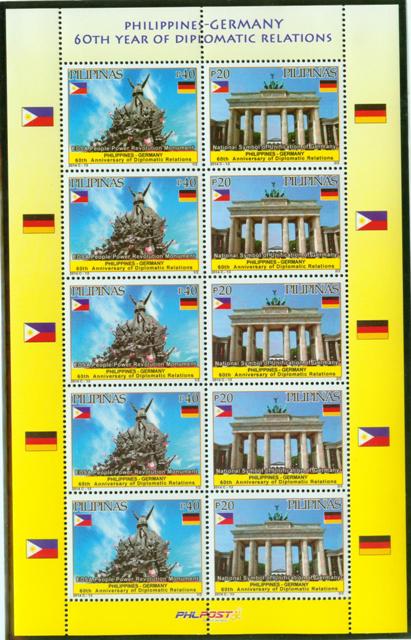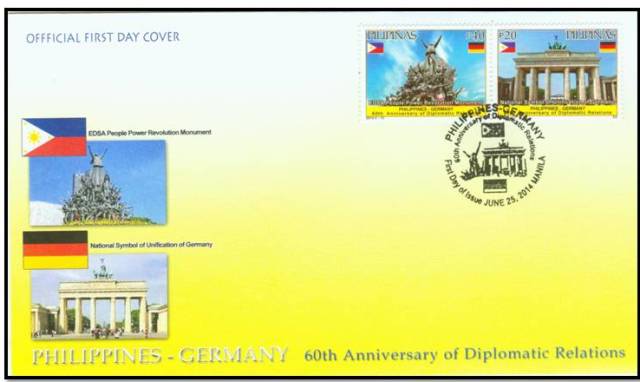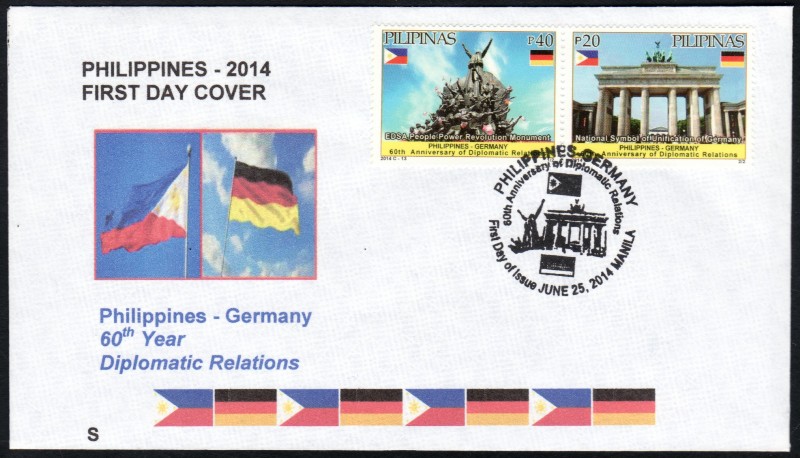2014, June 25. Philippines-Germany Diplomatic Relations - 50th Anniversary
Litho Offset, Amstar Company, Inc., Perf 14
Se-tenant Pairs, Miniature Sheets of 10


Se-tenant Pairs (40,000)
20p Brandenburg Gate of Germany
40p Philippines EDSA People Power Monument
Miniature Sheets of 10 (8,000)
Layout Artist: Victorino Z. Serevo
First Day Covers: Manila
Phlpost Official FDC Envelope
Privately Issued
PHILIPPINES-GERMANY DIPLOMATIC RELATIONS - 60th ANNIVERSARY
In 1954, an agreement was signed which led to a dynamic cooperation between the two countries of Philippines and Germany. Germany has an embassy in Manila and the Philippines has an embassy in Berlin. The German- Filipino relations goes back to the the 19th century when our national hero Jose Rizal lived in Germany and finished writing his famous novel Noli Me Tangere. It was published with the assistance of professor Ferdinand Blumentritt.
The People Power Monument at the corner of White Plains and EDSA Revolution depicts the thousands of Filipinos who gathered in front of the military camps at this main highway of the metropolis in February 1986, to unite in courage and faith to oust a dictator and restore democracry in the Philippines. The sculpture is by Ed Castrillo and was installed in 1993.
The Brandenburg Gate is a former city gate, rebuilt in the late 18th century as a neoclassical triumphal arch, and now one of the most well-known landmarks of Germany. It is located in the western part of the city centre of Berlin, at the junction of Unter den Linden and Ebertstraße, immediately west of the Pariser Platz, one block to the north stands the Reichstag building. The gate is the monumental entry to Unter den Linden, the renowned boulevard of linden trees, which formerly led directly to the city palace of the Prussian monarchs. It was commissioned by King Frederick William II of Prussia as a sign of peace and built by Carl Gotthard Langhans from 1788 to 1791. Having suffered considerable damage in World War II, the Brandenburg Gate was fully restored from 2000 to 2002 by the Stiftung Denkmalschutz Berlin During the post-war Partition of Germany, the gate was isolated and inaccessible immediately next to the Berlin Wall, and the area around the gate featured most prominently in the media coverage of the opening of the wall in 1989. Throughout its existence, the Brandenburg Gate was often a site for major historical events and is not only considered today as a symbol of the tumultuous history of Europe and Germany, but also of European unity and peace.
-
Monuments
-
Flags

